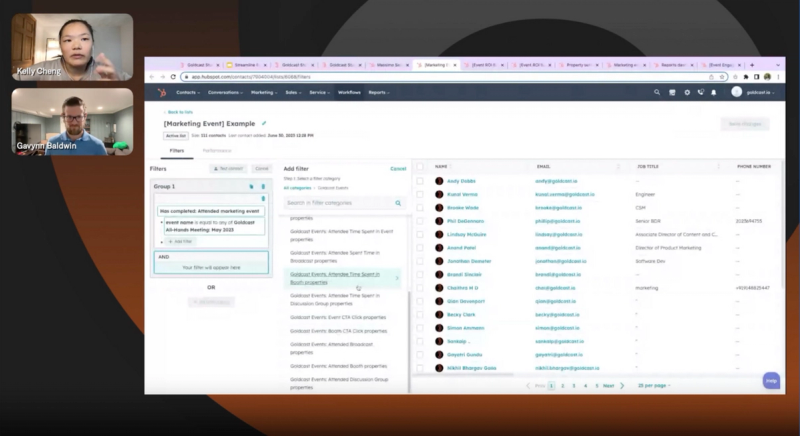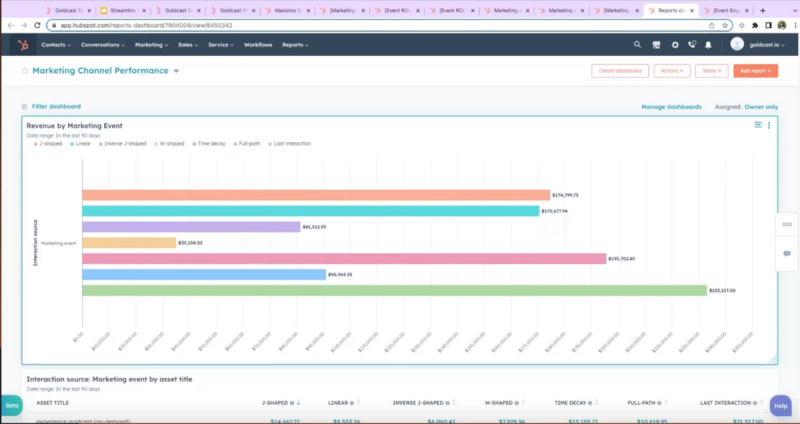7 Reasons Event Marketers Can’t Get Enough of HubSpot
Maximize Your Marketing ROI
Join 10,000 other marketers already getting the best tips on running engaging events that boost pipeline and create raving fans.
As a marketer in the 21st century, we don’t have to sell you on the benefits of using HubSpot.
With the ability to do everything from creating targeted content to crafting the perfect nurture campaigns, it’s basically the air you breathe. But, when it comes to capturing and using your event data—there can be a surprising amount of blind spots.
Which attendees need to be prioritized for follow up? What information do they need? What other campaigns are they tied to? And crucially…
How much ROI are you really getting from your events?
Whether you need to nurture attendees, capture key account activity, or launch targeted outreach campaigns, a deep integration between HubSpot and your event platform is key to turning attendees into new meetings and clients.
Here are seven simple reasons marketers love integrating their event platforms with the one-and-only, HubSpot.

#1. Life’s too short for manual entry
Imagine you fire up your laptop, log in, and immediately see a notification that one of your top accounts has just registered for your webinar. Pretty exciting, right?
Now imagine copy/pasting this person's details—name, email, all of it—from your event platform into your CRM, field by field. Yeah…that’s a little less exciting. 😑
Every new lead should feel like a win. Not anotheritem on your to-do list.
With your event platform seamlessly integrated with the rest of your HubSpot marketing operations, you can see the complete Timeline Activity of each contacts’ participation at your events.
That includes:
- Which events they registered for or attended
- Total time spent in each
- Whether they attended live or watched on-demand
- Questions asked and answered
Goldcast is the only digital event platform that lets you track up to 16 specific actions attendees take inside your event.
Actions show up in HubSpot as Contact Activity—not overriding fields. With a clear timeline view, you don’t have to worry about losing someone’s engagement history every time they attend a new event. 🙌🏻

#2. Workflow automation makes life easy
On the subject of registration, do you want to use HubSpot’s landing pages and forms? Your event platform’s landing page? Or, hey—why not embed your HubSpot form onto your event platform’s landing page?
As long as you’re working with an event platform provider that is truly “form agnostic”—like Goldcast––you can choose the event registration workflows you want to use. No complicated webhooks required.
But the real beauty in workflows is how easy they are to scale.
If you usually use the same forms for each event, you can easily duplicate your workflow, tweak the fields where necessary, and save a ton of time on setup.
With the right event platform, you can build repeatable workflows no matter how your marketing operations are set up. For example, if you're using HubSpot and Salesforce like we do, you can choose to manage all your events through Salesforce campaigns—simply select the campaign name and ‘registered’ status.
#3. Attribution is everything
Okay, maybe not everything. But in a world where B2B prospects require multiple multichannel touches, you can’t afford to overlook your event strategy in your lead scoring and MQL formulas.
With your event platform seamlessly integrated with HubSpot, you can use your UTMs to track your mediums, sources, content, and campaigns.
“We do all of our lead scoring through HubSpot. We just take our campaigns, sync them to Goldcast and Salesforce, and update all campaign statuses through workflows in HubSpot,” said Candace Gregg, Senior Director of Global Demand Generation at Bloomreach.
For Candace, it’s important that BDRs don’t waste time trying to understand which accounts are most in need of support following their events. In a matter of minutes, both the sales and marketing teams can see who’s registered, attended live, or attended on-demand.
When you use Goldcast and HubSpot together, you can also customize your lead scoring based on your event data.
For example, if an attendee clicks a demo CTA inside your event, you can assign 20 positive points to that high-intent activity. Simply choose your scoring criteria based on the attendee activity in your event platform and you’re ready to roll.
Want to see all your events in one place?
HubSpot’s Marketing Events feature gives you the complete high-level view of registrations, attendees, and no-shows from all events in your account; plus which lists and campaigns they’re associated with.
Wondering how much effort it takes to integrate HubSpot with Goldcast? Surprise! It takes less than six minutes to connect these two powerful tools. See how below!
#4. Create lists in a lot less time
At Goldcast, we use lists all the time to see which contacts registered or attended our events. It helps us plan our email campaigns, marketing automation list pulls, and so much more.
With HubSpot working in perfect sync with your event platform, you can easily filter your lists for any contact that has ever attended a marketing event. You can also filter by specific events using a simple dropdown or search.
Better yet, use your activity fields as filters to help you pinpoint your most engaged contacts. Want to see a list of contacts that attended your latest product demo and asked questions?
Boom. HubSpot makes it happen.

#5. Generic follow ups are so “twenty-tens”
But seriously. In 2023, there is no time for marketing fluff and jargon-y value props.
“The most important aspect of events, webinars, or anything that we do is always the follow up. Follow up is how you convert. You have to test different things out beyond just ‘Here’s your recording, I’m here if you need me,’” said Anna Suslova, director of global marketing programs at Axonius.
Anna is a big believer in the power of a well integrated tech stack. She and her team automatically push all qualified prospects straight from Goldcast into HubSpot, and then Salesforce. With all the right data at their fingertips, sales can hit the ground running with personalized follow-ups immediately after the event.
Want certain data going into Salesforce instead of HubSpot?
Whether it’s your Q&A, poll data, or anything else, Goldcast lets you decide which platform gets which data for each event. You can give your sales team a complete list of contacts who have attended your events, with the specific questions each one asked.
📚Read Next:How to Use Virtual Event Data for Better Sales Follow-Ups
#6. Get the automations you need when you need them
Want to sweeten the deal for your attendees? You already know HubSpot has a huge marketplace. Why not take advantage of it for your events?
Throw in a $5 gift card for coffee and donuts as a thank you for answering a poll, asking a question, or staying longer than 30 minutes. With HubSpot, there’s no more multiple exporting and importing—or manually handpicking the people who asked questions. 🥴
With a deeply integrated event platform, you can tap into the many different apps offered through HubSpot to elevate the attendee experience even higher.
And you can do it all automatically.
Simply choose your engagement triggers, plug your other applications into your existing HubSpot workflows, and automatically trigger a gift or reward via tools like Alyce, Sendoso, or Postal.io.
Want to get granular? You can set up a specific workflow based on an attendee’s event activity.
You can trigger workflows for:
- Registration
- Attendance
- Questions asked
- Polls answered
- CTA buttons clicked
- Attended a session for > 40 minutes
- And more!
Use your event activity triggers to automate a ‘thanks for your submission’ email and real-time Slack notification to your sales team—or tie event activity to any other key workflows that will help your team deliver an awesome experience at scale.

#7. Ramp up your reporting
Salesforce isn’t the only platform that gives you great reporting.
If you’re using HubSpot for reporting, you can see how your events are impacting your revenue based on different attribution models.
Here are some of the many attribution models HubSpot supports:
- J shape
- Linear
- W shape
- Time decay
- First interaction
- Last interaction
- And more
Use your HubSpot event reports for your quarterly business reviews, or to showcase how your events are impacting the business strategy and your overall ROI.
Drill down into deal amounts, the people associated with each deal, opportunities generated, and more. You can even sort by individual event asset to explore event-level performance.
In a matter of clicks, you and your leadership team can see exactly how events are impacting the entire funnel.

HubSpot is an event marketer’s best friend
For modern event marketers, HubSpot is a must. But to get the most out of it, you’ve got to make sure it plays nicely with your event platform.
Whether it’s creating a one-stop shop for your complete registration workflow, capturing and using account-level data, or tracking the real ROI on your events—HubSpot makes it happen.
And with the right platform, setup is both fast and easy.

Transform Your Video Marketing with AI
Stay In Touch
Platform
Resources
© 2025 Copyright Goldcast, Inc. All rights reserved.





 Upcoming Events
Upcoming Events Event Series
Event Series On-Demand Events
On-Demand Events

